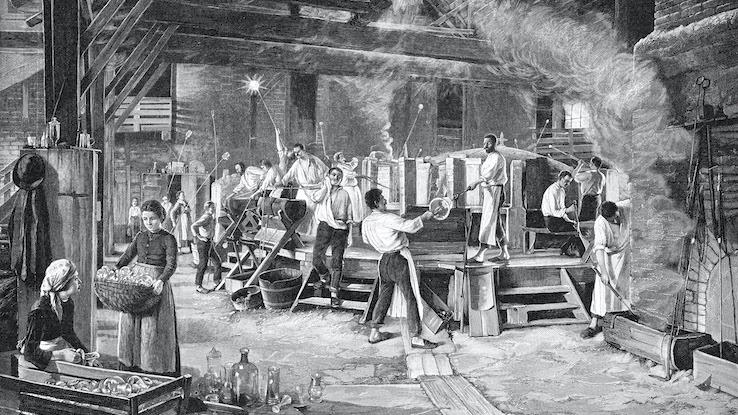You Have to Do It All Over Again Every Day

For nigh of the globe outside of the United States, Labour Day — a slightly unlike spelling than nosotros're accepted to in the U.S. — takes place on May 1 every year, not during the start weekend of September. Some countries telephone call it May Day or International Workers' Day, but the celebration commemorates the same concept. And while our Labor Mean solar day does fall later in the year, May Day is something that folks across the US bear witness up for on May 1st. On this day, people effectually the world celebrate with political demonstrations, often organized past labor unions and socialist groups. These demonstrations are not merely to honor the historical struggles of the working course, but to continue to button for improvements in workers' rights. But how did the holiday get its start, and what's the significance of May? As it turns out, Labour Day is multifaceted in meaning and represents some vital history.
The Early Days of Workers' Rights in Australia Inspired the Holiday
Earlier the 19th century, nothing that we'd retrieve of today as workers' rights actually existed. Toiling for a grueling 14 or even 16 hours a day was the norm. It wasn't until the early 1830s that the first labor unions were formed in Australia. These were associations of skilled laborers: shearers, stonemasons, chiffonier-makers, shipwrights and plasterers. Much like today, wealthy employers and the government were against early on labor unions.

However, these groups still fought for amend working conditions by hitting and enervating shorter working hours for each 24-hour interval. In 1844, they initiated the Early Closing Movement, in which they fought to reduce the length of the workday from xiv to 12 hours.
It was, in part, the circumstances in Australia at the time that helped with labor unions' early on success. In the tardily 1700s, Australia'south workforce was primarily fabricated up of convict laborers arriving from England. By 1840, transportation of convicts to the New S Wales colony came to a halt, and by 1847, the Anti-Transportation League — a group that was against the relocation of convicted criminals from Britain to the Australian colony — had formed. Just a few years afterward in 1852, they successfully ended convict transportation to Australia's east coast.
With no new forced laborers arriving, and with other residents venturing to North America to participate in the golden rushes there, the New S Wales colony faced labor shortages throughout the 1850s. Additionally, many laborers left to piece of work in Australia's own and so-recently opened goldfields. This demand for labor gave workers and unions more bargaining advantage as they fought for shorter hours and meliorate working weather.
On April 21, 1856, Melbourne stonemasons walked off their jobs and went on strike after their employers refused to mind to their demands for fewer working hours each day. The employers had no pick just to negotiate, eventually leading to an agreement. The stonemasons achieved what they were fighting for: an eight-hour-maximum workday.
Despite the victories of the stonemasons in Melbourne, the struggle for workers' rights continued effectually the world for many years. In the 19th century, working weather condition in the United States were so horrific that writers like Upton Sinclair and Jack London wrote novels bringing attending to the abysmal working conditions of laborers. It was not uncommon that they worked up to sixteen hours a twenty-four hour period in unsafe conditions.

While workers began to put upwards a fight for shorter working hours by the 1860s, it wasn't until ii decades later on that labor unions began specifically demanding an eight-hr workday. Their employers wouldn't budge, and so laborers took information technology upon themselves to make the change. May one, 1886, was the day the Federation of Organized Trades and Labor Unions decided the eight-hr workday would go into issue and become the standard for all laborers.
By mode of matrimony organizing, a full general strike involving hundreds of thousands of laborers rallied and protested across the U.Southward. In Chicago solitary, as many equally 40,000 workers took to the streets, walking out on their jobs to join marches. While most of the protesting was peaceful, by May 3, violence had begun to erupt when some workers surrounded strikebreakers trying to leave a mill. This led police to fire shots into the crowd, killing several people.
Labor activists and union workers held a rally in Haymarket Foursquare on May 4 to limited their outrage. Once again, the demonstration began peacefully but later escalated to violence while a British socialist named Samuel Fielden was speaking. As police tried to break up the crowd, someone lobbed a homemade bomb at them. I officer died immediately, and half-dozen others were mortally wounded. Gunfire between law and demonstrators ensued.
Multiple constabulary officers and demonstrators died as a event of what became known every bit the Haymarket Thing or Haymarket Riot. An additional lx constabulary officers were hurt, forth with dozens of demonstrators. The official number of demonstrators wounded is unknown, equally many forewent medical treatment in fear of being arrested afterward for their participation in the anarchism.
How Did Labour Day Get an Official Holiday?
May one became the official International Workers' Day in 1889 during the first International Socialist Congress in Paris. Three years afterwards the Haymarket Affair, this twenty-four hour period was called in remembrance of the event between striking workers and police force in Chicago.

As a result of trigger-happy protests continuing in subsequent years throughout the United states of america, the International Socialist Congress of 1904 declared that May Day would no longer exist a workday. The group called on all merchandise unions and Social-Democratic Party organizations to demonstrate on May one until a maximum eight-hour workday became law.
This limit didn't officially come up into practice for many workers until 1938, when President Franklin Roosevelt signed the Fair Labor Standards Act, requiring those who worked more than than 40 hours per calendar week to be paid overtime wages. It also established a minimum wage, youth employment standards and recordkeeping.
Workers' rights have never ceased to be a global outcome, and workers' voices will always deserve dignity. To reverberate both workers' progress and the continued need to fight for standards and fairness, much of the world even so recognizes International Workers' Mean solar day, or Labour Day, on May 1.
Why Does the United states of america Celebrate Labor Day in September?
May one became the official date to commemorate workers internationally considering that date honored a far-reaching strike that took identify in the United States. Therefore, it may seem strange that the U.Due south. doesn't gloat its Labor Solar day on May 1, instead marker it on the kickoff Monday in September. But, there's a reason for this.

Despite spurring progress for workers, the Haymarket Matter was hard for many Americans to process considering of the violent ways police officers handled the events that May. To complicate things further, public trials of eight "anarchist activists" followed the riot, and they were establish guilty of murdering the police force officer who died immediately when the flop was thrown into the oversupply that day. The judge sentenced seven of them to death, and i was given 15 years in jail. However, their supposed involvement in the bombing was never proven, thus making the Haymarket Affair a contentious event for Americans to memorialize.
As such, May 1 wasn't seen as a time of celebration for many people in the U.S. even before it became the official international Labour Day. To effort to minimize the chances of glorifying violence that happened during the Haymarket Affair, and to forestall farther violence or sympathy with socialism, President Grover Cleveland established Labor Mean solar day in the United States as the commencement weekend in September in 1894.
Still, demonstrations continue to occur on May Mean solar day in the U.S. The labor movement is alive and well (and fighting a creative fight). You lot might see people on the street this May 1st advocating for a reduction to the forty 60 minutes work calendar week, amidst other things. Now y'all can understand these people every bit more than than simply protestors, but as office of a long-fought, historical struggle. Whether a country calls it Labour Day, Workers' 24-hour interval or another name, its purpose remains the same: to uplift workers, recognize their struggle and celebrate labor movements that strive tirelessly to secure basic human rights.
Source: https://www.reference.com/history/why-celebrate-labour-day-may?utm_content=params%3Ao%3D740005%26ad%3DdirN%26qo%3DserpIndex
0 Response to "You Have to Do It All Over Again Every Day"
Enregistrer un commentaire